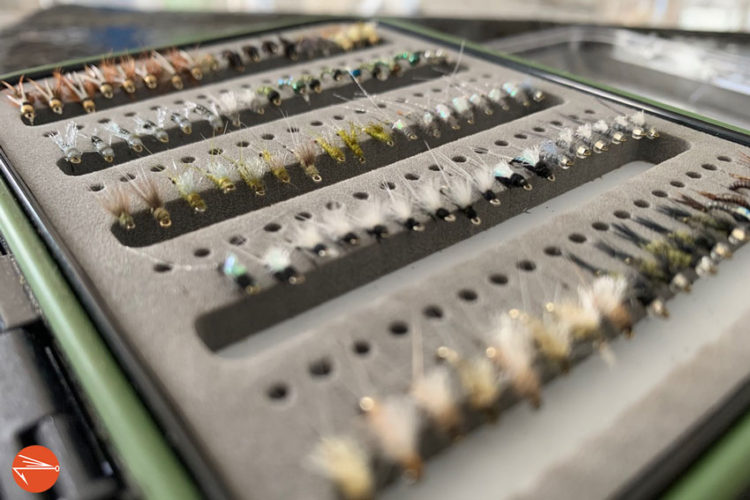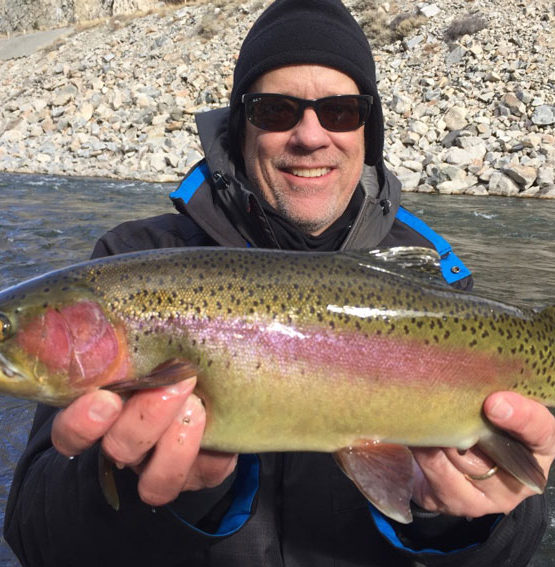Fly box organization is a surprisingly important task for anglers. So, if you’re looking for a few tips on how to organize your fly box, stick around. In this post, I’m going to cover 6 of the best ways to do just that.
As a fly fisher’s experience grows, so, too, does the amount of flies collected. Assuming it’s not some wimpy little thing, your first fly box will probably hold you for a while. But it won’t be long before more fly capacity becomes necessary, and, take it from me, that’s when the dilemmas start.
Sure, trying to figure out how to organize multiple fly boxes doesn’t rise to the level of great challenges in human history, but if you suffer from the very real “fear of not having” many anglers endure, you’ll be thankful for the extra thought you put into your fly box arrangement ahead of time. With that in mind, here are 6 great ways to organize your fly box.
Disclaimer: This post may contain affiliate links, meaning we will receive a small commission (at no cost to you) if you click through and make a purchase.1. By Fly Type
Arranging by fly type may be the most logical way to organize your flies, especially if you tend to fish the same bodies of water frequently. For instance, as a Colorado resident, most of my fly fishing time is spent on Colorado waters.
Seems logical, right?
And though each of the rivers and lakes I frequent feature a few local flavors, there are a slew of flies that will work on every one of them. I’ll get into arranging by regions later, but, if your situation is similar to mine, organizing your flies by the following types will serve you well.
Nymphs
If you take this fly box arrangement thing from the river-bed up, you’ll want to start with your larva and pupa imitations. Line them up with like-flies next to one another (i.e. all black RS2s, all Copper Johns, etc.) and from smallest to largest, row-by-row, until you fill out either a whole panel or an entire box. Assuming you took our advice on buying see-through fly boxes, you shouldn’t need to label them but, for easy visibility, you may want to anyway.
A good electronic label maker comes in very handy for this.
Worms, Eggs & Crustaceans
Once you’ve finished slotting in all your nymphs, I recommend dedicating a full open panel (or box) on, or in which you’ll start mounting your worm, egg and crustacean imitations.
Since worms run long, you may want to slot each of them into every other slip, and then, on the next row, use the alternate slips, brick-like, until your worms are all tucked in. Yes, this leaves empty spaces, but that will give you more room to get them out if, like me, you’ve been blessed with weirdly large fingers.
I’d probably recommend you load your crustaceans in next.
Scuds are the most common form of these, but some rivers feature a healthy population of mysis shrimp, crayfish and other such exoskeleton beauties.
Next, run in a handful of egg patterns. I don’t keep a lot of egg “flies” but they can sure come in handy when nothing else is working.
Dries
I recommend following the nymph-loading logic when slotting in your dry flies.
So, go with like-flies, smallest to largest, row-by-row until you have all your go-to dries lined up, all pretty-like, making sure not to crowd them in too tightly, giving each plenty of room for tails, wings, hackle and parachute posts.
Terrestrials
Terrestrials tend to run large, but, since there are quite a few of them — ants, beetles, etc. — that start out on the more diminutive side, arrange terrestrials like your dries: like-insects, smallest to largest, row-by-row, leaving room for hackles, wings, legs, tails and parachute posts. For the same basic reasons, you may want to incorporate the brick-laying method (mentioned in the worm section above) for your terrestrials.
Once laid in correctly, these babes will take on the appearance of battlefield Howitzers standing at the ready. Boom!
Streamers
In all honesty, streamers can be difficult to fit into a standard fly box. Some of the articulated jobs are about as fly box friendly as are the fish they catch, short net friendly.
In other words, big things don’t fit well into small packages.
That said, some of the standard streamers – Wooly Buggers, Thin Mints and the like — can occupy a go-to streamer box, while some of the more exotic, articulated, bird-like streamers might need another home, say, your unoccupied rod tube or your dad’s old buick.
2. By Fly Size
Most anglers know what kind of fly fishing their day holds in store for them. For example, when heading out to a Rocky Mountain river in early spring, it’s a good bet the fish fare will be of the small morsel variety. That doesn’t necessarily mean just tiny nymphs; it will likely include a few midge, baetis or BWO hatches.
Thus, keeping a fly box filled with nothing but small nymphs and dries would keep an angler from having to carry too many boxes.
Alternatively, later in the summer, when fish are looking up at hefty Drakes, Stimulators and Hoppers, a box full of big flies — inclusive of big attractors and terrestrials — might be all he or she needs.
In both cases, having arranged your fly boxes by size would be a perfectly good way to go.
3. By Season
Since certain flies are known to hatch throughout the year, arranging my flies by season isn’t my favorite way to go.
That said, whether you organize your flies deliberately by season or not, fly boxes tend to naturally align with the seasons anyway, so many anglers choose to just run with this method by default.
Pretty easy formula here. You can arrange by calendar seasons: spring, summer, winter, fall. Or go with a tad more fly fishing season specificity: late winter/early spring, late spring/early summer, late summer/early fall, late fall/early winter.
4. By Region
If you happen to be blessed with a lifestyle or schedule that allows for more than the usual amount of fly fishing travel, you may wish to set up your fly boxes according to the local fly flavors that are more indigenous to the regions you frequent.
Together with some of the other fly box organization tips I’ve mentioned in this post, I use the by-region method most often.
Arranged for the most common areas I fish (and employing previously discussed organization practices), I have several fly boxes for Colorado, three or four for Montana and a growing number for Wyoming.
And just because you have them arranged by region doesn’t mean you can’t intermingle different area-targeted boxes in your vest or pack, should the nation to do so arise. Often, those inner hunches you run with play out rather well!
Related Posts:
- 15 Best Nymphs For Colorado (Here’s What You Need)
- 12 Killer Foam Flies You Need To Try
- 10 Baetis Nymph Patterns You Need To Try
5. By Body Of Water
A variation on the regional organization style above is the more specific by-river method. Every body of water I’ve ever fished has a local set of flies that are either fairly unique to it or, if not unique, the fish fare doesn’t deviate much from year to year.
Given that truth, setting up your fly boxes specific to the various bodies of water you fish can be a good way to go.
By the way, this method is very helpful when it comes to remembering which flies worked the last time you hit that body of water. It also makes it easy to take a quick inventory of how many local delicacies you have and which flies you need to resupply.
Related Posts:
6. By Favorites
I don’t set up all my fly boxes with my favorite flies, but I carry one box of all-timers that I am rarely without. According to the methods outlined above, it is not arranged very well. But I know every fly in it and where and when each is most likely to work. Call me superstitious, but I don’t like to mess with this fly box very much; I don’t want to disrupt its mojo, if you know what I mean.
As a side note, in this special box, I always leave a few slots unoccupied for that newly discovered, can’t miss fave.
Fly Box Organization: Summary
There you have it, a bit of incredibly insightful, if not, insanely OCD, advice for how to organize your precious and pricey flies.
More than likely, you’ll incorporate several of the above (or none of the above) as you sit down to put order to your fly arsenal.
Regardless of how you go about it, lining up your flies in some sort of meaningful order will give you a strange sense of peace in your soul, which is not unlike what happens to you when you sign up to receive Fly Fishing Fix in your inbox.
And who doesn’t need a little more soul peace these days?
Tight Lines!










